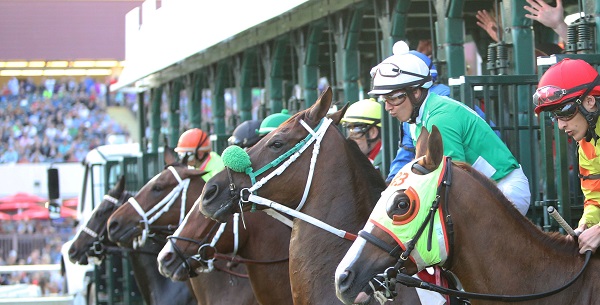By Jim Wells
At long last, the racing season is upon us, two weeks earlier than usual, two and half hours earlier than ordinary, and yet surely not early enough for anyone who has spent the last few months huddled indoors, handicapping races via simulcast from tracks hither and yon.
Opening day’s 4 p.m. start is an anomaly and yet welcome relief for racing fans deprived these past few months of their prerace trips to the paddock. Saturday’s card is also unusually timed to mesh with the Kentucky Derby. First post in Shakopee is 1:45 p.m., with the grand sendoff in Louisville scheduled for 5:45 p.m. The early start on opening day will allow fans to get their feet wet with a couple of live races before the simulcast of the Kentucky Oaks.
Anyone familiar with the background of horse racing the past decade is aware too of the shortage of horses that has bedeviled racetracks throughout the county, a consequence of changing economics within and outside of this expensive endeavor.
That is at least a partial explanation for the early start this season, a decision Canterbury management hopes will land some of the horses that have been departing Oaklawn Park in Hot Springs, Ark., where that meet ended mid-April.
That and, of course, the marketing angle employed in introducing fans present only because of the Derby to the concept of live racing as well.
That is part and parcel of the return to live racing on the first weekend of May.
“Combining live racing with the spectacle of the Kentucky Derby is ideal,” said track president Randy Sampson. “Derby Day is often the one day casual sports fans come to the racetrack, perhaps for the first time. Introducing them to live racing at the same time will enhance the experience and perhaps encourage another visit.”
Historically, the first Saturday in May is the largest wagering day of the season at Canterbury and the local handle will likely benefit as well. Minnesotans are notoriously tight-fisted bettors, so local racing needs to take advantage of every opportunity for vigorous exchanges at the pari-mutuel windows. The Kentucky Derby is first on the list. Management expects a wagering handle on Derby Day of $1.8 million or more.
Horsemen seem generally to have accepted the idea of an earlier start to the meet, particularly in this case, associated as it is with attracting additional stables.
“I was talking about that with (Hall of Fame trainer) Bernell Rhone the other day,” said trainer Jerry Livingston. “Just about every track seems to have a shortage of horses except Remington Park during the quarter horse meet.”
That does not seem to be the case in Shakopee on opening day. Stables, including a handful of new ones, have been arriving steadily with the horse population growing daily.
The HBPA, for one, is encouraged by what has taken place prior to opening day.
“It appears we have around 900 horses now and they are expecting full barns,” said president Jack Walsh.
There are other differences this season immediately apparent in the group that represents horsemen. Walsh pointed that out earlier in the week following an HBPA meeting. “It’s not the same without Tom here,” said Walsh, who took over following the death of Tom Metzen last summer. “The board members had hardly anything to do with Tom around. He had it all done. It was always so smooth.”
Walsh said that horsemen in general understand the need for an earlier start to the 67-day season. Most of them understand the realities of an industry that struggles across the country to maintain fan bases. Full barns relate to larger fields and enhanced interest and betting in races. Competitive races are no different than any other sport. Competition drives interest and enjoyment in the product. Compare the attention devoted to the Minnesota Vikings during the first half of the 2016 season and what took place thereafter.
Mac Robertson, Canterbury’s champion trainer in 2016, says the early start is beneficial to his barn, offering as it does additional spots over a longer period of time to place his horses, as well as additional opportunities for his owners to see their horses run. “Obviously the more racing there is, the better off I am,” he said.
Simply stretching the season as the 2017 calendar does, from May 5 until closing day on September 16, allows trainers a wider widow in which to compete. “I don’t have to worry about running them back too soon,” added Robertson.
Successful trainers with large stables and owners from various parts of the country (or countries) frequently have to compete during the same period of time at more than one location. Robertson does and his toughest opponent for the training title, Robertino Diodoro, continues to expand his operation.
Robertson had won nine consecutive training titles in Shakopee before Diodoro interrupted that streak with titles in 2014 and 2015. Robertson was back on top again in 2016, and there’s no reason to think those two conditioners won’t go head-to-head again this meet.
Diodoro, however, will have stables for the first time at five locations this summer. “We’ve done four tracks before,” he said. “This is the first time with five.”
Diodoro has 50 horses at Canterbury for opening day with perhaps the same number at Prairie Meadows in Des Moines, Iowa. It’s not a stretch to say that his vans will be making frequent if not perhaps weekly trips between the Iowa and Minnesota tracks this summer.
And he will help kick off the 2017 meet in grand style. He has three horses entered in the first race of the season.
